|
Delta
Electric Company in World War Two
Marion, IN
1913-1964
1964-1968 as a division of Novo Industrial Corporation
1968-1977 as a division of United Filtration Corporation
1977-1978 as part of Halle Industries
This page updated 10-27-2022.
An American Auto
Industry in World War Two Special Edition
The Delta Electric Company moved from Chicago,
IL to Marion, IN
in 1916, after controlling interest in its stock was
purchased by several Marion businessmen. Throughout its history,
the company's main focus was portable lighting products. The
company produced the first battery-powered handheld lantern. Other
civilian products included flashlights, lanterns, and
lighting for bicycles and vehicles made by the American Auto
Industry in the 1930s. During both World Wars, Delta Electric built
lanterns, flashlights, and other lighting devices for the U.S. Army and
Navy.
The Delta Electric Company was located at 33rd
and Nebraska Streets in Marion, IN. The factory is no longer at
this corner. Three of the corner lots are empty with the fourth
being a building too small to have been the Delta factory.
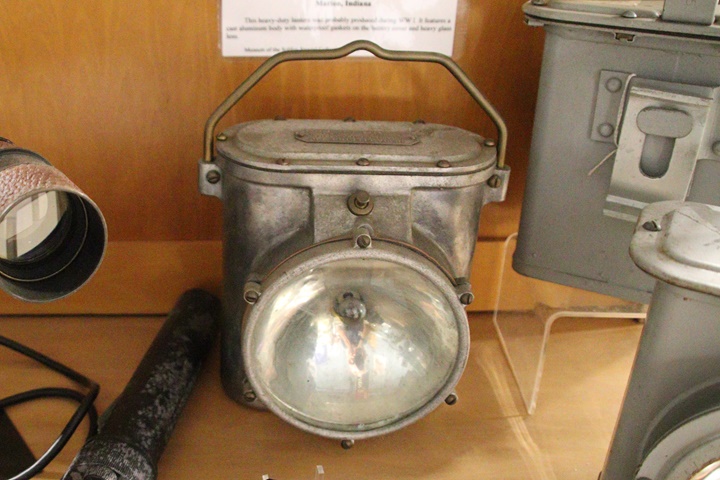
This handheld battery-powered lantern was
produced by Delta Electric Company for the U.S. Navy during World War One.
The Type F lantern has an aluminum body and rubber gaskets to make it
watertight.
Delta Electric Company World War Two
Products: The U.S. Navy purchased watertight lanterns and
flashlights for emergency lighting on Navy ships. The company also
made life preserver lights, signal gun lights, life raft float lights,
blinker lamps, electrical boxes, running lights for ships, and battle
lamps. For the U.S. Army, Delta built signal gun lights, beach
debarkations marker lights, and parachute cargo dropping lights.
For either service, it made aircraft gunnery tow target lamps, aircraft
recognition lights, and flashing flares. Delta produced 70,945
headlights for bicycles produced for the U.S. military. The
company also built headlight plugs on early World War Two era
half-tracks.
During World War Two, the company had $8,109,000 in major
military contracts from the U.S. Army, U.S. Navy, and the Maritime
Commission.
Table 1 - Delta Electric Company's
Major World War Two Contracts
The information below
comes from the "Alphabetical Listing of Major War Supply
Contracts, June 1940 through September 1945." This was
published by the Civilian Production Administration, Industrial
Statistics Division. Table added 4-29-2022. |
|
Product - Customer |
Contract Amount |
Contract Awarded
Date |
Completion
Date |
| Lanterns - Navy |
$283,000 |
11-1941 |
5-1942 |
| Electrical
Equipment - Navy |
$926,000 |
12-1941 |
2-1943 |
| Lanterns Electric
- Army |
$101,000 |
2-1942 |
7-1942 |
| Controls Box -
Army |
$153,000 |
3-1942 |
7-1942 |
| Lanterns Electric
- Navy |
$187,000 |
4-1942 |
7-1942 |
| Lanterns Electric
- Navy |
$113,000 |
4-1942 |
7-1942 |
| Lamp Assemblies -
Army |
$460,000 |
4-1942 |
8-1942 |
| Lanterns Electric
- Army |
$287,000 |
7-1942 |
4-1943 |
| Lanterns Electric
- Navy |
$91,000 |
8-1942 |
1-1943 |
| Lanterns - Army |
$80,000 |
11-1942 |
6-1943 |
| Lights - Navy |
$86,000 |
12-1942 |
4-1943 |
| Lanterns Electric
- Army |
$115,000 |
1-1943 |
6-1943 |
| Lanterns Electric
- Navy |
$144,000 |
1-1943 |
8-1943 |
| Lanterns - Navy |
$58,000 |
1-1943 |
5-1943 |
| Lanterns Electric
- Navy |
$182,000 |
2-1943 |
8-1943 |
| Lanterns Electric
- Navy |
$177,000 |
2-1943 |
3-1943 |
| Lights -
Signaling |
$151,000 |
2-1943 |
12-1943 |
| Flashlights -
Army |
$62,000 |
2-1943 |
4-1943 |
| Lifesaving
Equipment - Navy |
$52,000 |
4-1943 |
6-1943 |
| Flash Light
Equipment - Army |
$70,000 |
6-1943 |
6-1943 |
| Flashlights -
Navy |
$752,000 |
8-1943 |
6-1944 |
| Ship Emergency
Lights - Navy |
$70,000 |
8-1943 |
12-1944 |
| Electric Fixtures
- Navy |
$148,000 |
9-1943 |
2-1944 |
| Electric
Flashlights - Navy |
$81,000 |
10-1943 |
3-1944 |
| Electric Signal
Lights - Navy |
$168,000 |
11-1943 |
10-1944 |
| Electric
Flashlights - Navy |
$218,000 |
2-1944 |
6-1944 |
| Flashlights -
Navy |
$69,000 |
3-1944 |
9-1944 |
| Lantern Converter
Sets - Army |
$83,000 |
3-1944 |
6-1944 |
| Lantern Converter
Sets - Army |
$209,000 |
3-1944 |
12-1944 |
| Life
Preserver Lights - Army |
$199,000 |
3-1944 |
9-1944 |
| Hand Lanterns -
Maritime Commission |
$71,000 |
4-1944 |
10-1944 |
| Electric Hand
Lanterns - Army |
$405,000 |
4-1944 |
4-1945 |
| Electric Lanterns
- Navy |
$320,000 |
5-1944 |
10-1944 |
| Flashlights -
Maritime Commission |
$88,000 |
5-1944 |
9-1944 |
|
Gasoline Lantern Parts - Army |
$169,000 |
5-1944 |
10-1944 |
| Electric
Signaling Lamps - Navy |
$220,000 |
7-1944 |
1-1945 |
| Signal Generators
- Army |
$78,000 |
8-1944 |
12-1944 |
|
Electric Flashlights - Navy |
$62,000 |
9-1944 |
1-1945 |
| Life
Preserver Lights - Army |
$67,000 |
10-1944 |
6-1945 |
| Electric Lanterns
- Navy |
$51,000 |
12-1944 |
2-1946 |
| Lantern Relay
Assys - Navy |
$94,000 |
12-1944 |
4-1945 |
| Electric Lanterns
- Navy |
$162,000 |
1-1945 |
5-1945 |
| Lanterns MX290 -
Army |
$168,000 |
2-1945 |
6-1945 |
| Life Lights -
Army |
$56,000 |
2-1945 |
8-1945 |
| Electric Lanterns
- Navy |
$82,000 |
3-1945 |
4-1945 |
| Lanterns MX290 -
Army |
$146,000 |
5-1945 |
9-1945 |
| Electric
Flashlights - Navy |
$103,000 |
6-1945 |
9-1945 |
| Total |
$8,109,000 |
|
|
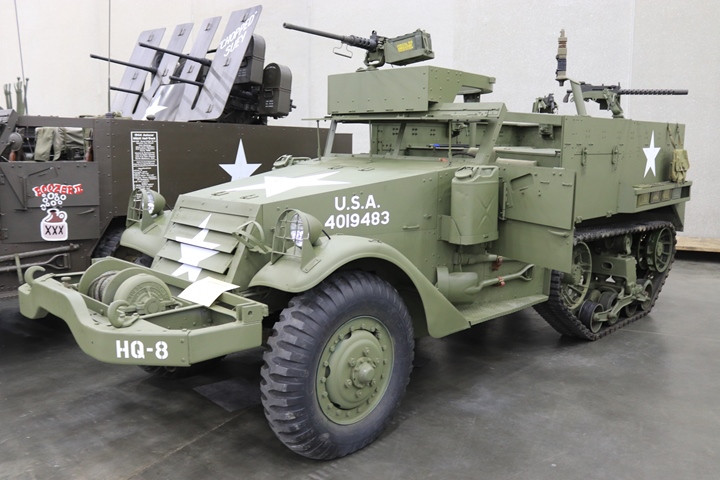
Delta Electric supplied two each of part
number DL-A-74s headlight plugs for only early World War Two era half-tracks like this M2A1. The later models that did
not use the Delta Electric plug had the blackout light attached to the
top of the headlight. Of the 40,003 half-tracks built by Autocar,
Diamond T, and the White Motor Company, about half of the surviving
examples didn't have the blackout light attached. Therefore, Delta
Electric would have supplied approximately 40,000 headlight plugs. Author's
photo added 9-20-2020.
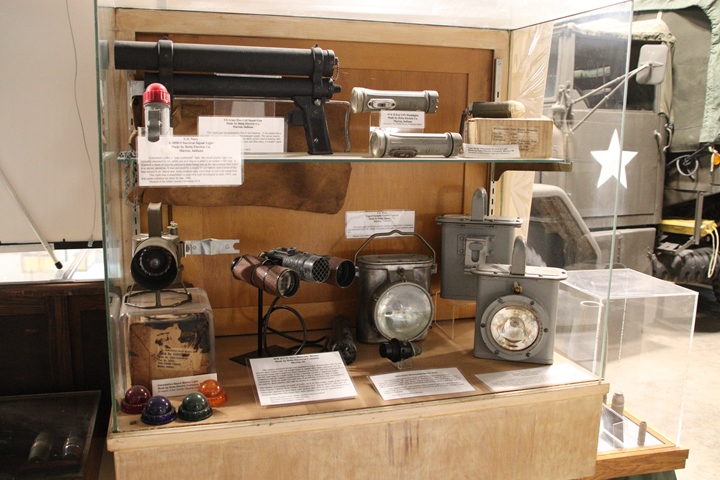
This display of Delta Electric Company
military products is located at the Museum of the Soldier in Portland,
IN. This is a very cool military museum that contains a large
variety of displays and historical artifacts. One of the museum's
specialties is the collection and display of products made by Indiana
companies for the U.S. military, with emphasis on World War Two.
Many of the photos on this
page are from the display at the Museum of the Soldier. Photos of
Delta Electric Company products from other museums are also included. All photos are by the author.
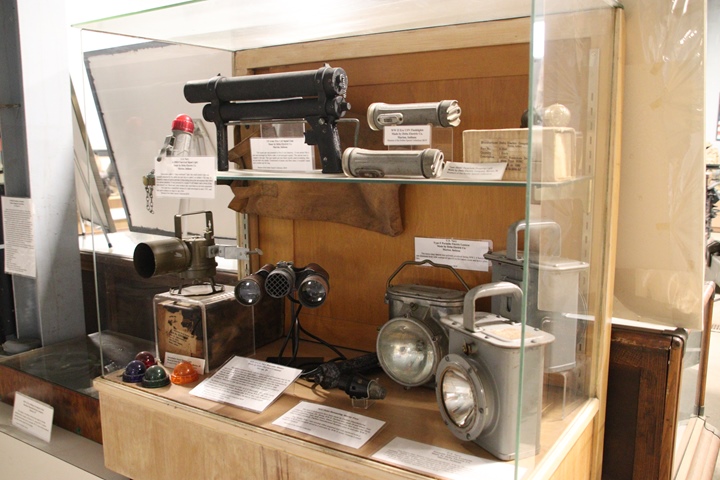
There are six different product types in the
display at the museum.
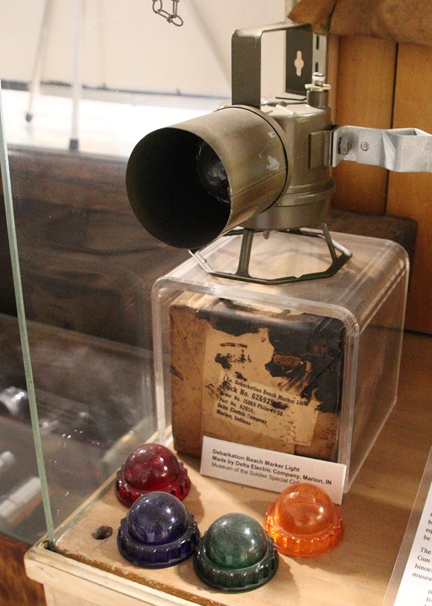
This is a Debarkation Beach Marker light for
the U.S. Army. From the description of the item, several of these
would be set up on the landing beach by the first soldiers ashore for
incoming landing craft to
designate where each landing area was located. There are four different colored lenses which could define
whether it was red, blue, green, or yellow beach. I was unaware
there was such a light for this purpose and have learned something by
visiting the Museum of the Soldier.
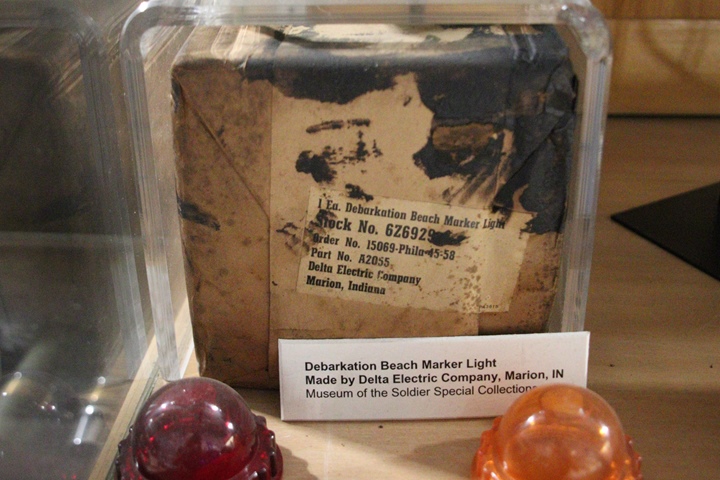
This product was ordered by the Army, as
the Order No. has "Phila" in it. This was ordered by the U.S. Army
Quartermaster Depot in Philadelphia, PA.
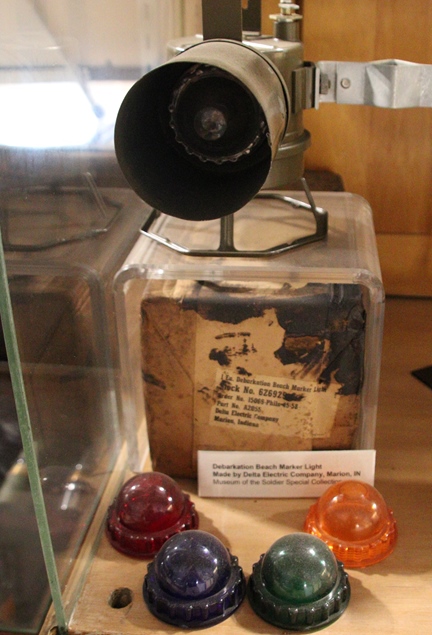
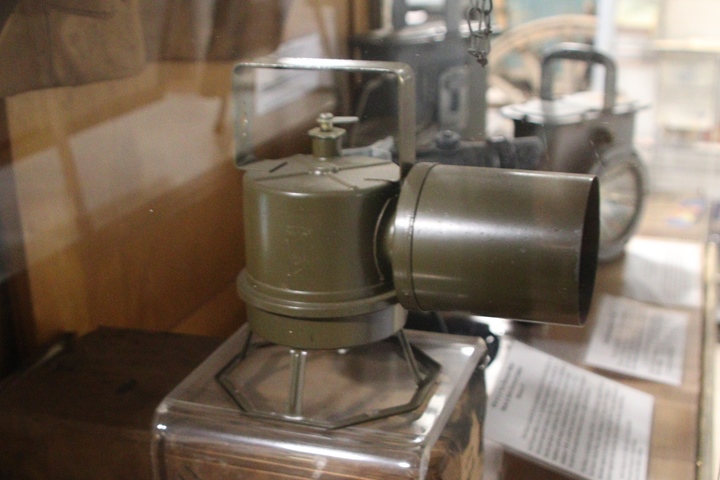
This side view shows the metal stand that
would be set down in the sand on the beach. There is a lever at the top
which is the ON switch for the battery-powered light. This
is a unique product and display.
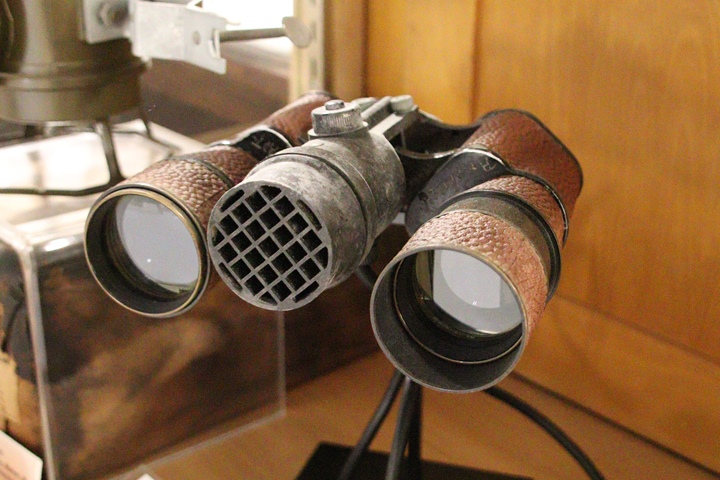
This is another unique Delta Electric
Company product on display at the museum. The binoculars were not
made by Delta, but the battery-powered signal light in the middle was.
The knob at the top is a rheostat for adjusting the intensity of the
light, while the small button at the top would turn the light beam on and off. The beam was low power, to focus for signaling
short distances. This was a portable unit that may have been used
by Navy beach masters to communicate with incoming
landing craft from invasion beaches.
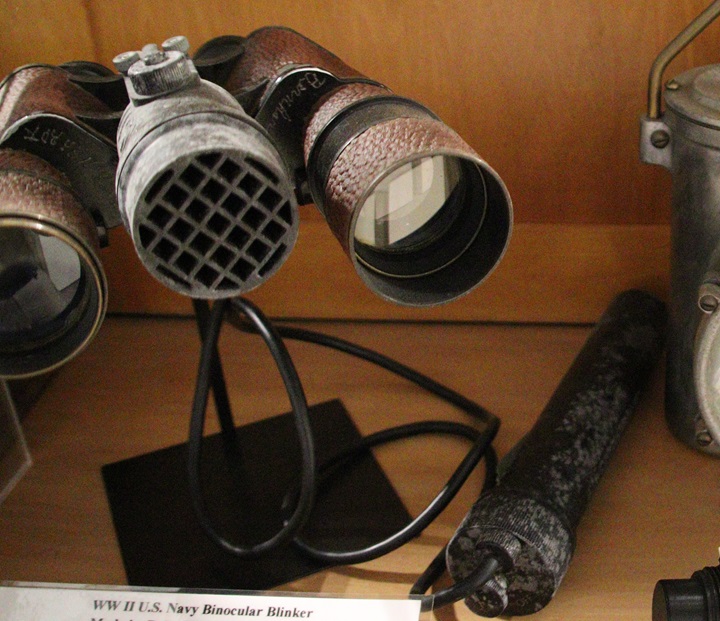
This angle shows the power cable to the battery
container, which looks like it would contain four D-cell type batteries.
The battery power supply allowed the unit to be operated where
there was no power, such as a landing beach.
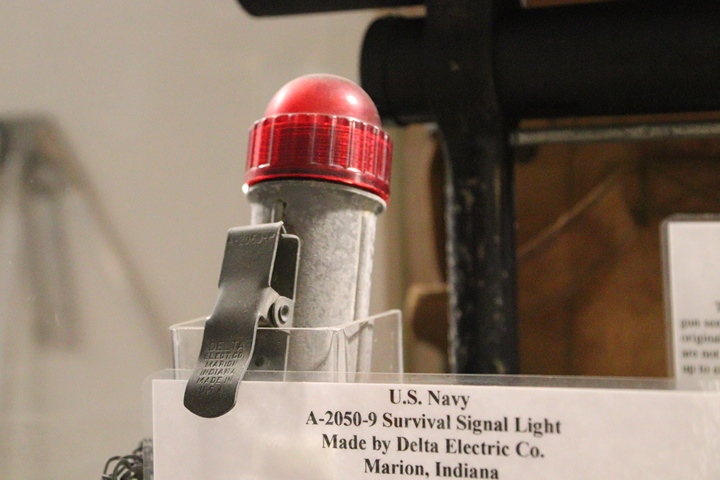
For a sailor who went overboard off of a ship
or boat in the night, this Delta Survival Signal Light could make all
the difference as to whether he was rescued. Once in the water,
the sailor would turn the lens to activate the light to give his
location in the water. The light was powered by one D-cell
battery. As can be seen, the unit clipped to the sailor's shirt or
life jacket.
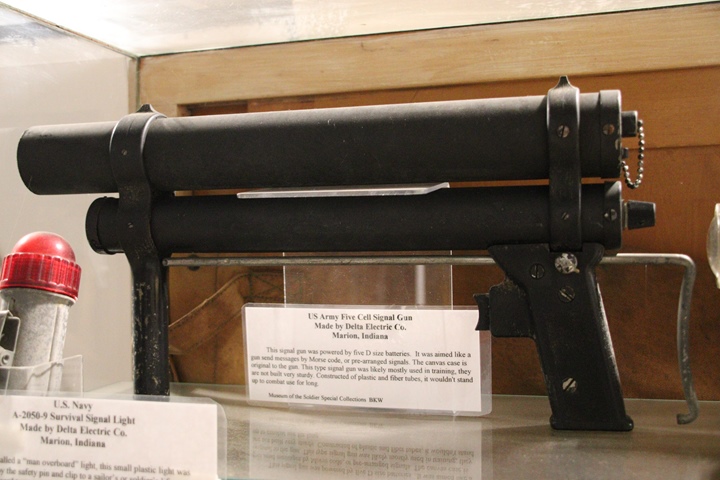
As is noted below the display, this is a
U.S. Army Signal Gun powered by five D-cell batteries in the lower tube.
The construction is of plastic and vulcanized fiber tubing. This
suggests it was used in training, as it is not robust enough for combat.
This is just another interesting and unique item at the
Museum of the Soldier.
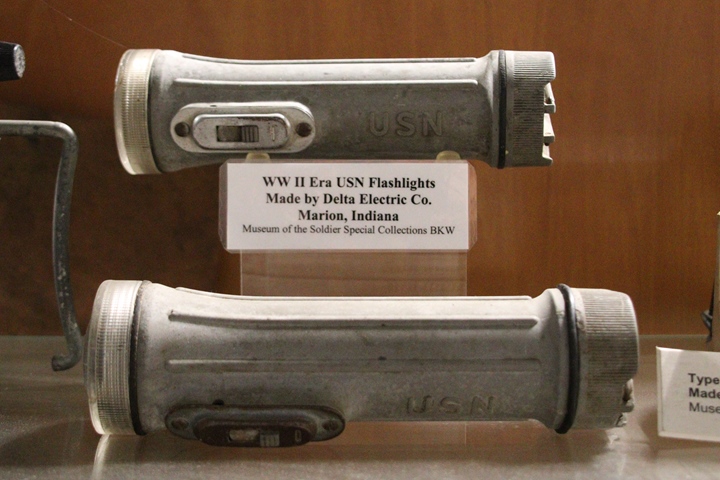
The display contains two Navy flashlights.
The cases and end caps look to be made of aluminum die cast, making
them robust units. Rubber gaskets make the flashlights waterproof.
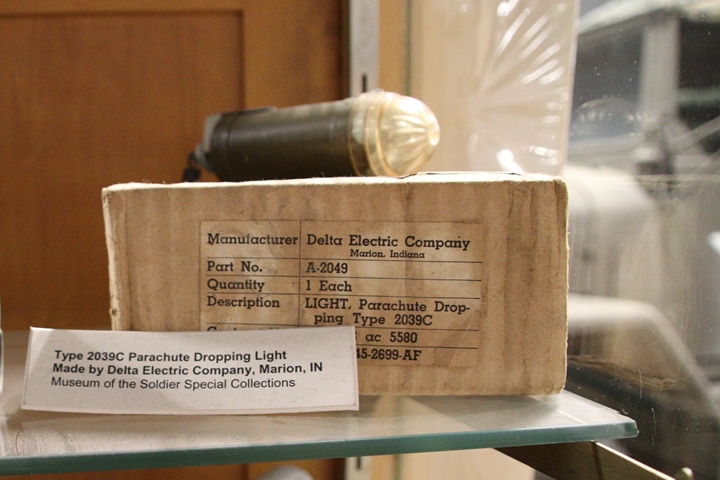
This light was built for the U.S. Army. Such
lights were
attached to supplies parachuted to troops on the ground, so the items
could be located in the dark.
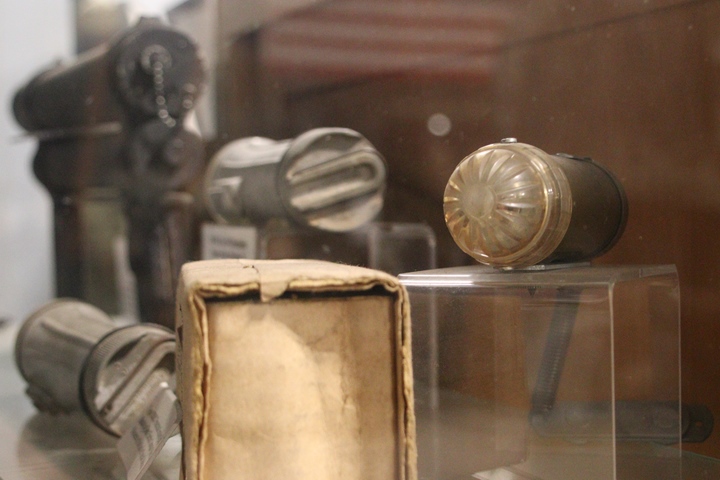
This photo shows the top of the
Parachute Dropping Light plus the end caps of the Navy flashlights.
The end caps have extendable hooks that can be attached to a sailor's
belt.
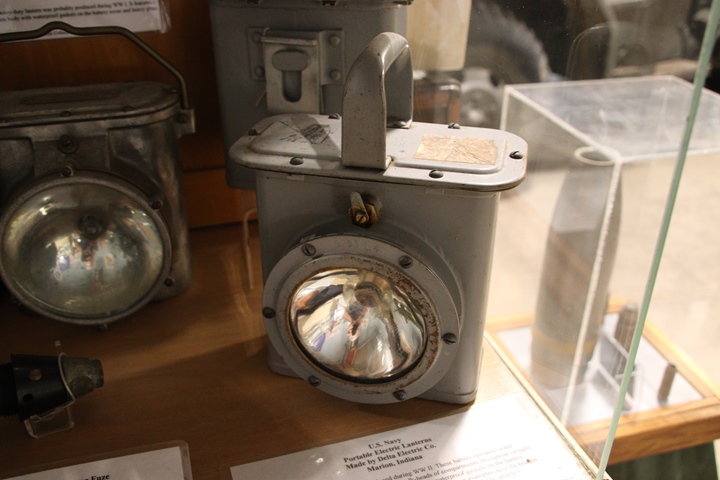
This is a World War Two ear battle lantern that
was attached to the bulkheads of Navy ships for use if the power went out
during combat. The small lever on the front of the lantern would
turn on the unit and light up the immediate area.
It could also be removed from the bulkhead for personal use. The batteries for
all of these units would need to be checked on a regular basis, to make
sure they still had a charge, and had not corroded.
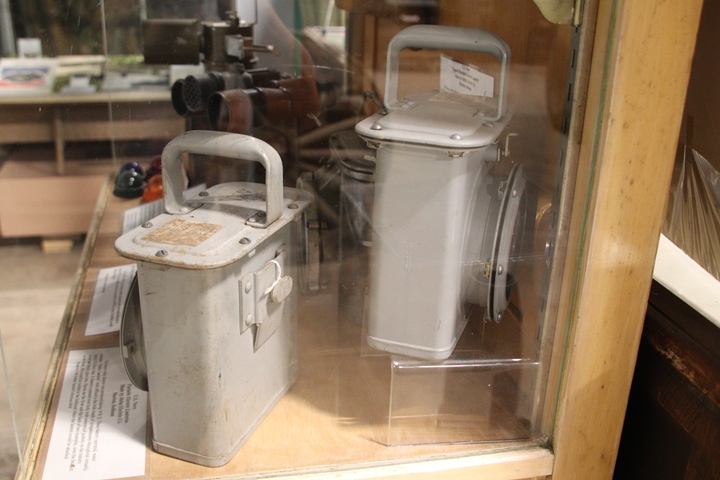
This photo shows the back of the lantern
with its mounting button. It also shows how to load or remove the
batteries, requiring six or eight screws to be removed, depending on the
model type. These are heavy duty units
constructed of painted steel.
As noted above, this unique display is located
at the Museum of the Soldier in Portland, IN. For the military
historian or enthusiast, this is a really cool museum located in east
central Indiana. The museum has limited hours during the
summer months, so some advance planning is needed to visit. It
will be worth it.
The following four photos of a World War Two
Delta Electric U.S. Navy lantern are from the John Stanton collection.
The lantern is unusual as it is made of brass. The others shown on
this page appear to be made of painted steel. Several of
the painted examples are showing signs of rust indicating they are of
steel construction.
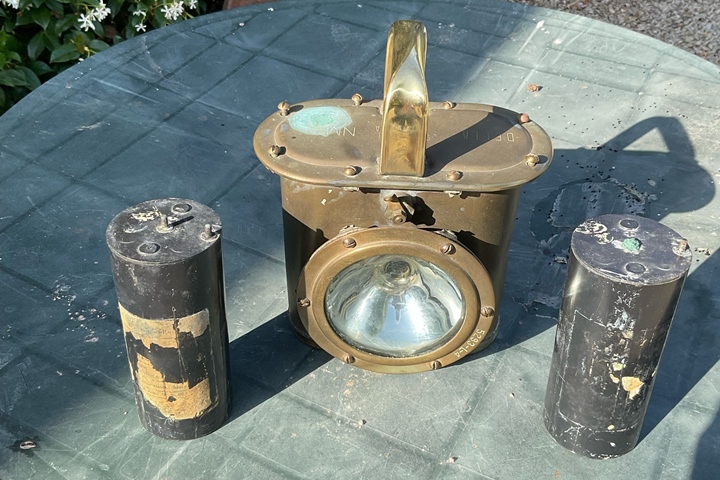
This photo shows that the lantern was powered by two dry cell batteries.
Photo courtesy of John Stanton added 10-27-2022.
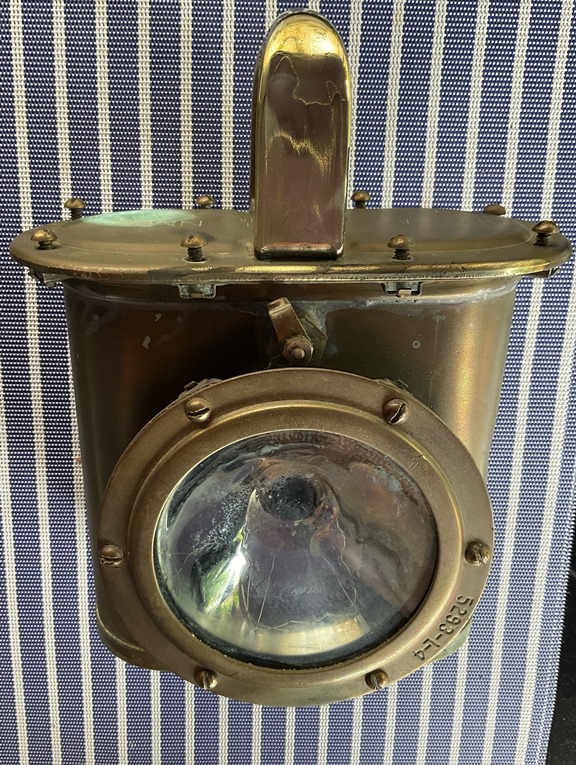
Photo courtesy of John Stanton added
10-27-2022.
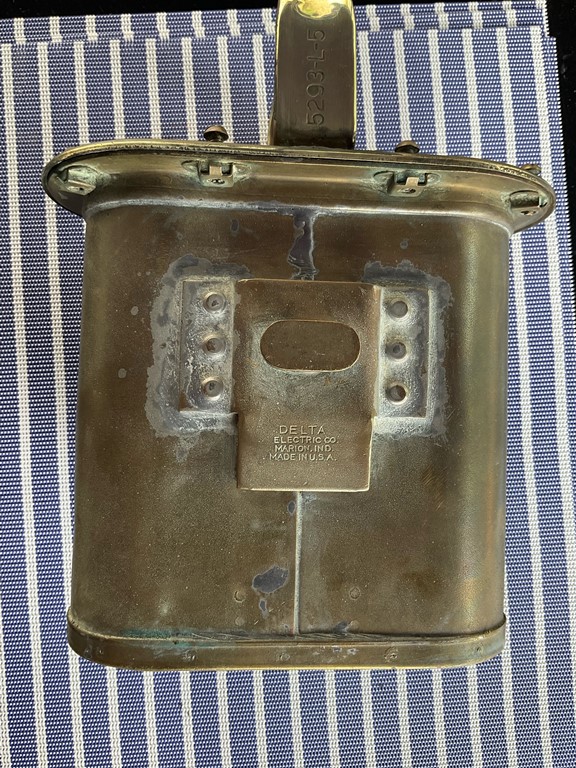
This photo shows how several pieces were
soldered together to make the lantern. Photo courtesy of John
Stanton added 10-27-2022.
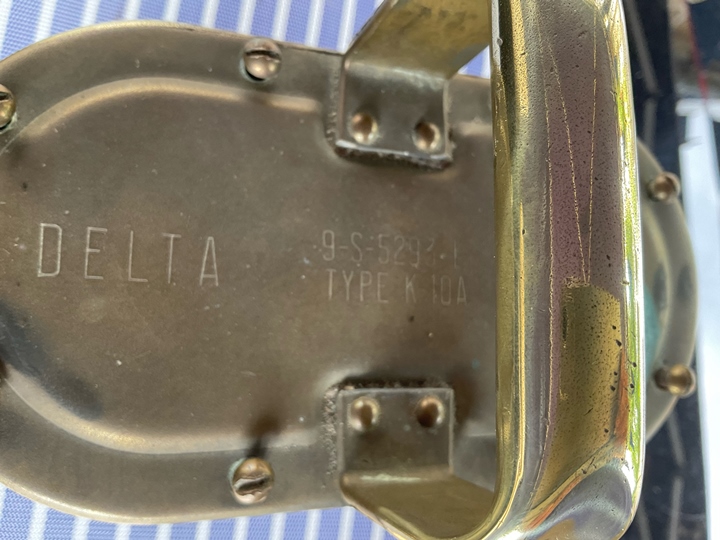
The top of the lantern lid indicates that this is
a type K-10A lantern. Photo courtesy of John Stanton added
10-27-2022.
Below are more Delta Electric World War Two
products on display at
other military museums.
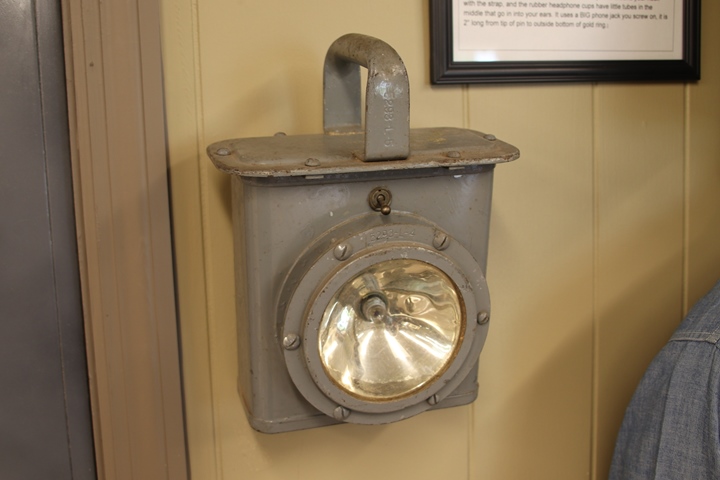
This is one of two Delta Electric Company
U.S. Navy lanterns on display at the Central Ohio Military Museum
in Harrisburg, OH. This museum opened in 2018. Note that this model of
the lantern has a toggle switch to turn it on.
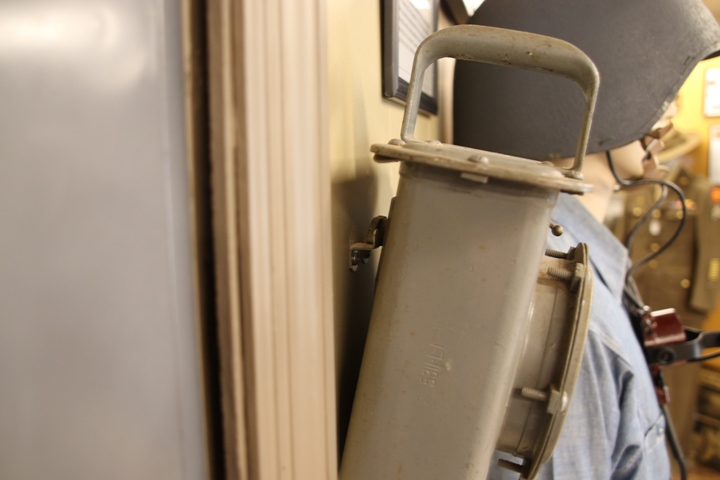
The museum has the lantern mounted to the
wall, similar to how it would be mounted on the bulkhead of a ship.
The lantern could either be turned on to provide emergency lighting in
the compartment it was in or be taken off the bulkhead for use by a
sailor.
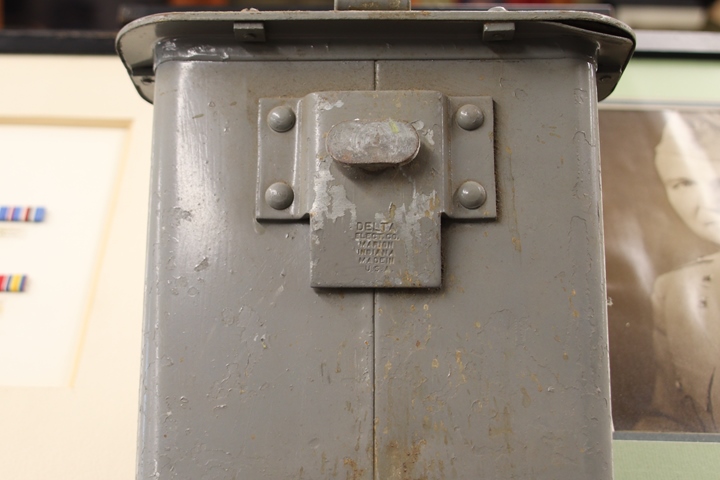
Bob Traphagan, the curator of the Central
Ohio Military Museum, was most helpful in moving around various
items in the museum that I wanted to photograph.
Here is the backside of the lantern, showing the mounting bracket with
the Delta Electric name and address stamped into it.
Special thanks go out to Mr. Bob Traphagen, the
curator of the Central Ohio Military Museum. Bob went above and beyond
the call of duty to assist the author in showcasing the historic
artifacts of this museum. There were several items that needed to be
moved or handled, and he assisted me with that. Included in that
group were the lanterns, the flashlight, and a Galvin Handie-Talkie.
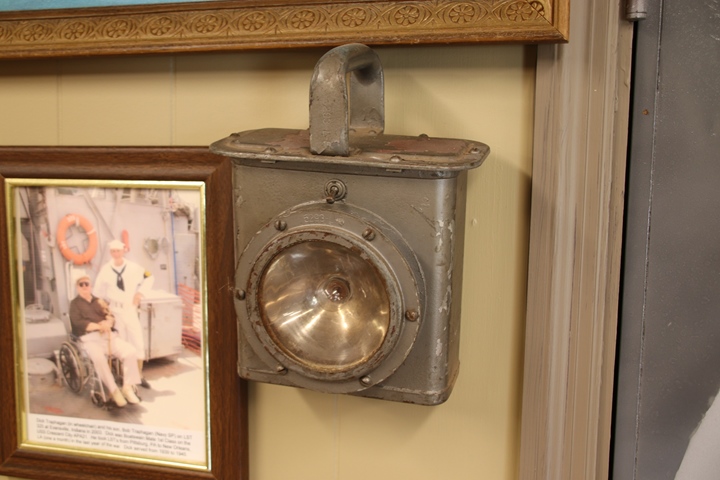
The other Delta lantern is next to a photo
of curator Bob Traphagan when he was in the Navy. Next to him in
the photo is his father, who also was a Navy veteran.
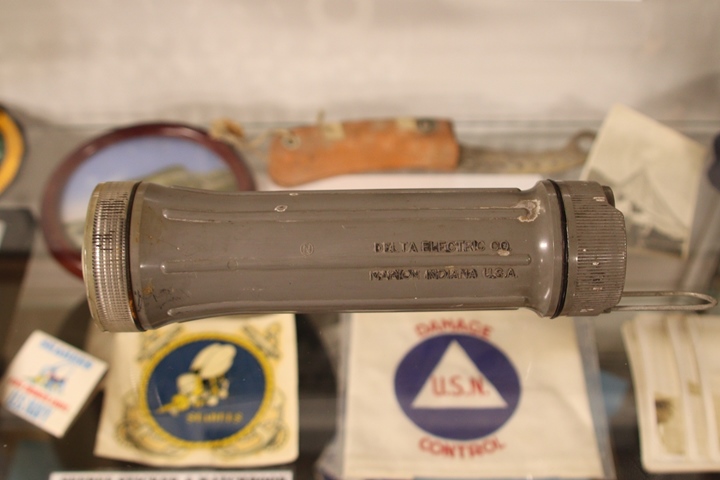
The museum also has a U.S. Navy flashlight on display. Note the
wire loop on the end that allowed a sailor to attach the flashlight to
his belt.
This was my first visit to the Central Ohio Military Museum. I
plan to return to this excellent museum just south of Columbus,
OH.
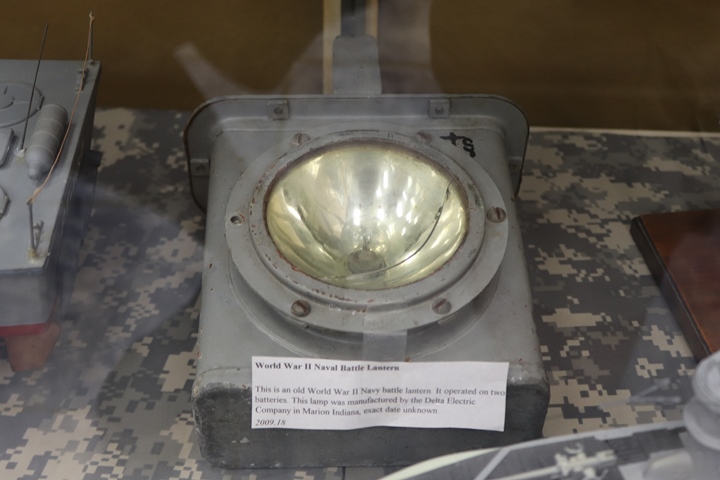
This Delta Electric Lantern was photographed
at the Museum of Military History in Kissimmee, FL.
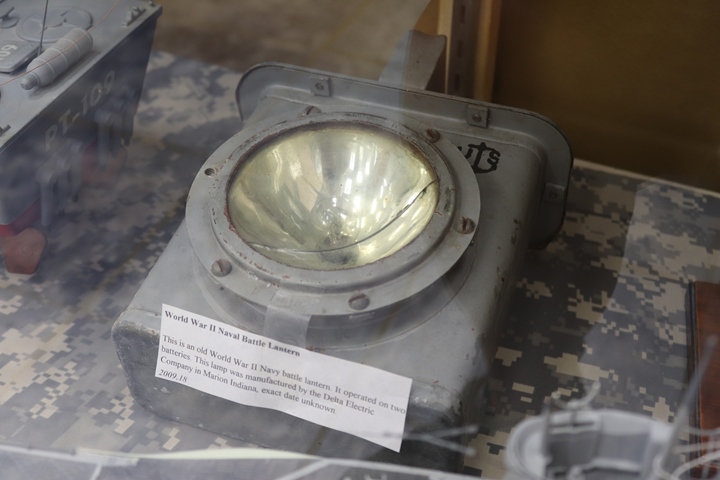
The Museum of Military History in
Kissimmee, FL is another of those small military museums gems, like the
two previously mentioned. The museum is not too far from the
main entrance to Disney World.
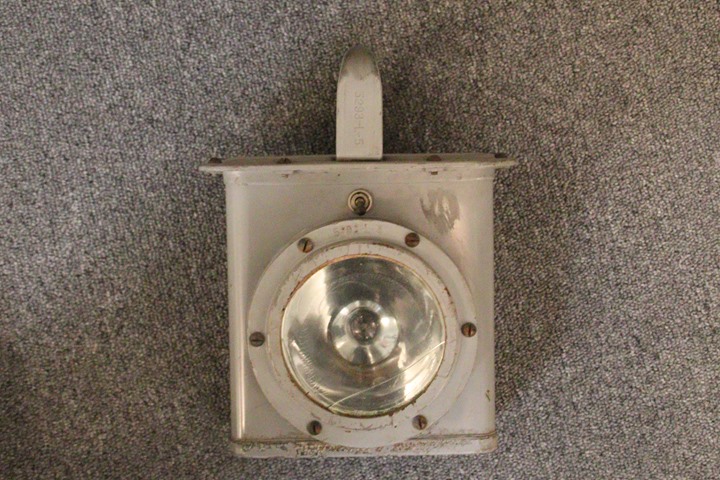
This Delta Electric Lantern was photographed
at the Fighting Falcon Military Museum in Greenville, MI. Author's
photo added 4-25-2021.
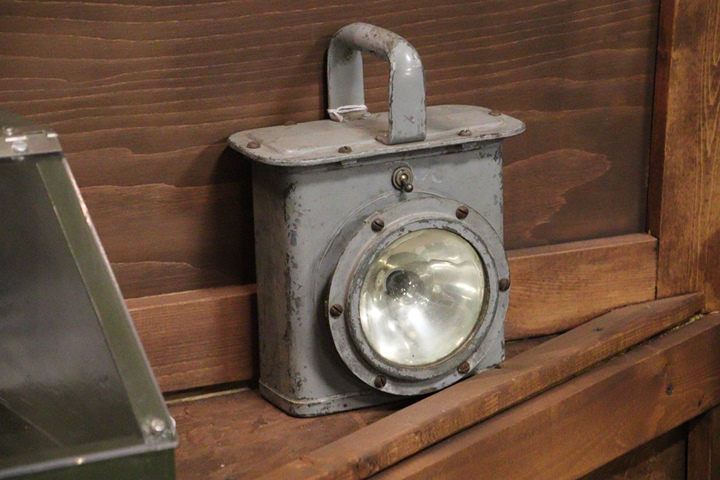
Another Delta Electric lantern is on display at the Michigan
Military Technical and Historical Society in Eastpointe, MI.
Author's photo added 4-25-2021.

This Portable Type A Signaling Light is on
display with its carrying case at the LST-325 Museum in Evansville, IN.
Author's photo added 4-29-2022.

Author's photo added 4-29-2022.
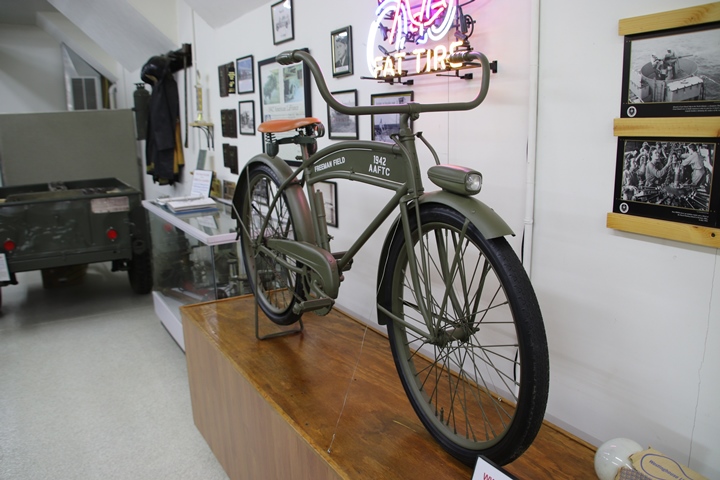
Delta Electric supplied the headlights for
the 70,945 bicycles produced for the U.S. military during World War Two.
This one is on one of the 19,750 bicycles built by the Huffman
Manufacturing Company (later known as Huffy). Author's photo added 3-2-2022.
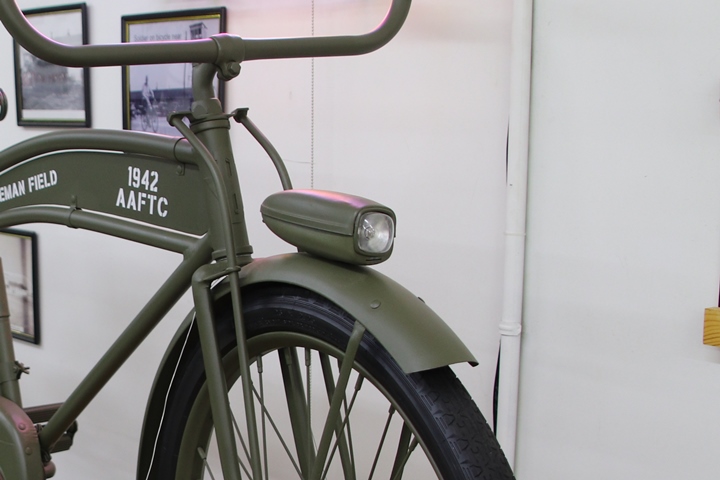
Author's photo added 3-2-2022.
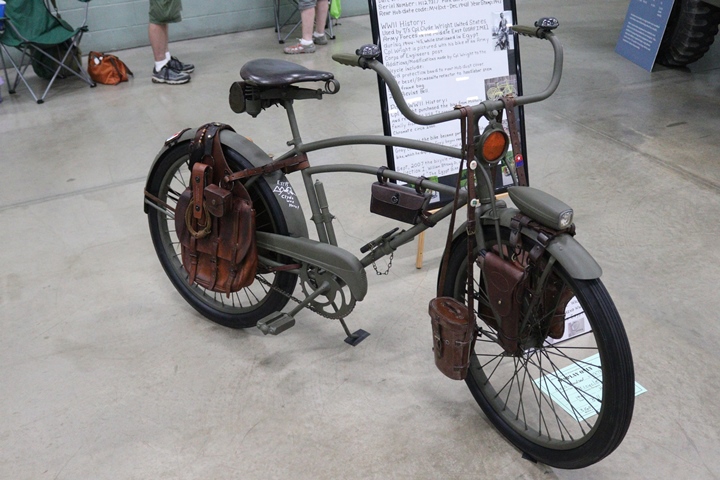
This Huffman-built bicycle with a
Delta-built headlight served with the U.S. Army in Egypt. Author's
photo added 3-2-2022.
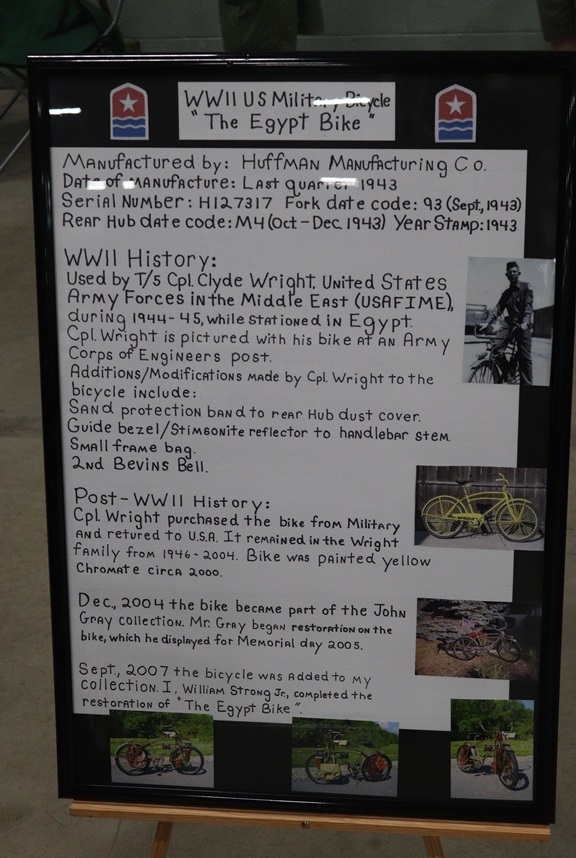
Author's photo added 3-2-2022.
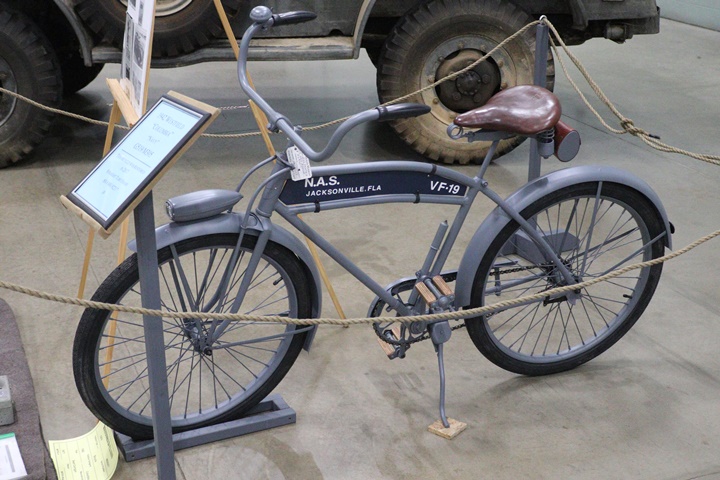
Delta supplied 51,195 headlights for the
military bicycles built by Westfield Manufacturing Company.
Author's photo added 3-2-2022.
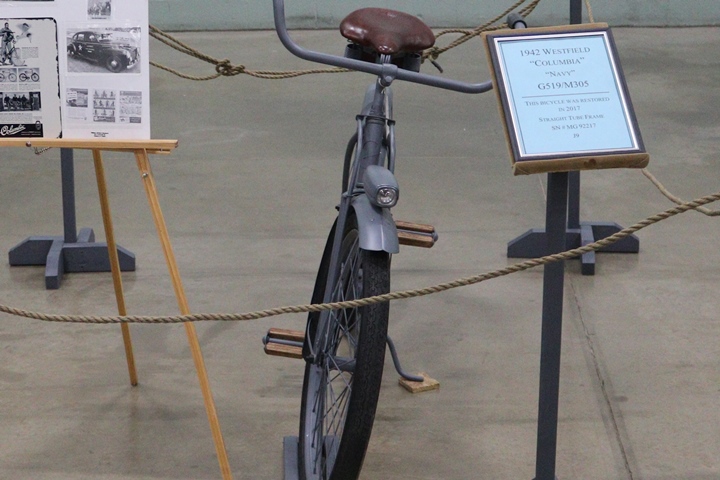
Author's photo added 3-2-2022.
|





































